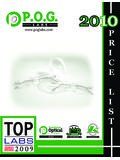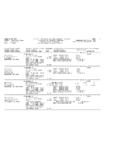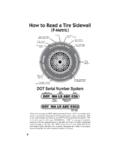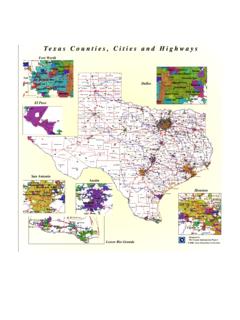Transcription of I N S I D E T H I S Basic Cardiology Coding - I S S U …
1 Basic Cardiology Coding - INSIDE THIS. ISSUE: Stress Tests and Transthoracic Echocardiograms By Monique Vanderhoof, CPC. Q&A corner 2 A stress test evaluates a patient's heart during physical or pharmacological stress and is generally performed on a bicycle or treadmill. During a stress test a patient will usually exercise until symptoms occur or patient reaches a maximum heart rate (85% of predicted ICD-10 Planning for 4 heart rate based on age). If the patient is physically unable to exercise or is taking medica- your career tions that depress heart rate, pharmacological stress can be substituted for exercise. Pharmacologic stress agents can be billed separately by the entity that provides them.
2 Audio Conference Common stress agents are Adenosine, Dobutamine, Dipyridamole and Arbutamine. Schedule Series 2: 5 To report both exercise and pharmacologic stress: July-December 93015 Cardiovascular stress test using maximal or submaximal treadmill or bicycle exercise, continuous electrocardiographic monitoring, and/or pharmacological stress;. with physician supervision, with interpretation and report Encryption Myths 6. 93016 physician supervision only, without interpretation and report 5010 update 6 93017 tracing only, without interpretation and report 93018 interpretation and report only Caution in Coding Under CCI edits, codes for electrocardiogram (93000-93010), rhythm strip (93040-93042), from Code Number 7 pulse oximetry (94760-64761) and Injection or Infusion (90774) are all included in the stress Instead of Diagnosis test and should not be reported separately.
3 Echocardiograms E&M Coding : Echocardiography uses high frequency sound waves to record the structure of the heart and Prescription Drug Management and the 8 blood flow within the heart. Transthoracic echocardiograms (TTE) are the most common type of echo performed. During TTE a transducer is moved on the surface of a patient's Table of Risk chest to obtain images that are captured for analysis. EKG monitoring is also performed to assist in evaluating the heart in different stages of cardiac cycle. Heart chamber size, con- CMS Principles for traction, wall motion, wall thickness and valve structure can all be evaluated using echocar- 9. Facility E&Ms diography. Doppler echocardiography is often used to detect acute complications following a myocardial infarction.
4 RAC Updates 10 Doppler color flow imaging evaluates the blood flow through the heart and displays flow data on 2-D echocardiographic image. Doppler wave form imaging provides directional information about flow, velocity and characteristics. Wave form is obtained when a Contact Info 11 transducer transmits a series of pulses to detect motion. Continued on following 12042 SE Sunnyside Rd #452. Clackamas, OR 97015. COMPLIANCE CONNECTIONS Page 2. Basic Cardiology Coding To report TTE: 93303 Transthoracic Echocardiography for congenital anomalies; complete 93304 follow-up or limited study *Please note codes 93303-93304 are to be used for patients with congenital anomalies only 93306-Echocardiography, transthoracic, real-time with image documentation (2D), includes M-mode recording, when performed, complete, with spectral Doppler and color flow Doppler echocardiography (93320 and 93325 are now bundled with this code and should not be reported separately).
5 93307 Echocardiography, transthoracic, real-time with image documentation (2D), includes M-mode recording, when performed, complete, without spectral Doppler or color flow Doppler echocardiography 93308-follow-up or limited study + 93320 - Doppler echocardiography, pulsed wave and/or continuous wave with spectral display. + 93321 - follow-up or limited study + 93325 - Doppler echocardiography color flow velocity mapping Sometimes a physician will order a Stress Echocardiogram to evaluate the motion of the heart's walls and pumping action when the heart is stressed. This will help him/her to better determine a lack of blood flow that isn't always apparent on other heart tests. During a stress echo images are recorded before, after and sometimes during stress.
6 Patient's EKG, heart rate and blood pressure are also monitored before, during and after test. The goal is to evaluate hemodynamic, electrocardiographic and echocardiographic responses to stress. To report stress echo: 93350 - Echocardiography, transthoracic, real-time with image documentation (2D), includes M-mode recording, when performed, during rest and cardiovascular stress test using treadmill, bicycle and/or pharmacologically induced stress with interpretation and report + 93352 Use of contrast agent during stress echocardiography For more on Cardiology Coding visit our website and sign up to attend our upcoming June audio conference titled Cardiology Coding for the Physician Office. Monique Vanderhoof, CPC, joined RMC in September 2011 as Manager of HCC Services, focusing on HCC Coding reviews and client education.
7 With over 15 years' experience as a clinic manager, Monique has extensive experience working in both outpa- tient and inpatient physician billing with an emphasis on Cardiology . Her skills also include EHR implementation, HIPAA, eRx, and Meaningful Use readiness and attestation. NEW TO RMC EDUCATION? 2012 Audio Conference: Series 1 is now available on CD! Cost is $50 per CD. Past topics include: ICD-10 Intro; OIG Workplan & OPPS. Highlights; Perinatal Conditions; Podiatry; Cardiology . Contact for more information! See page 5 for upcoming audio conferences! COMPLIANCE CONNECTIONS Page 3. ICD-10 Planning for Your Career-A Practical Viewpoint Laura Legg, RHIT, CCS. ICD-10 has been coming for years.
8 If other Coding professionals are anything like me, they have largely ignored it as CMS. kept pushing back the deadline. I made the decision 6 months ago to begin taking the transition seriously so that I would not be left behind. My Coding career has been good to me for a number of reasons; primarily it has kept me learning. Learning ICD-10 has proved to be a challenging but important endeavor as the differences between it and its predecessor (ICD-9) are significant. Coders need to be the experts and to do that they must start now! Start by doing research. As a Coding consultant doing research has become second nature. Through reading articles on my favorite websites and participating in several AHIMA calls, I familiarized myself with some of the new terms like root operations ; characters vs.
9 Digits ; qualifiers etc. Unlike ICD-10-CM codes that are different but easy to grasp, ICD-10- PCS codes present more of a challenge. At first exposure, just looking at them confused me! Being a hands-on learner, they did not start to become clear until I began applying them. (Ten digits? Alphanumeric? What means what? No deci- mal how will I keep this all straight? These codes look ridiculous and messy!). Knowledge of anatomy and physiology is more important than ever in ICD-10 due to greater specificity in the new codes. For instance, one code no longer covers the same procedure done in different anatomical locations, so it is important that you begin increasing your knowledge now. When you code a procedure and don't fully understand the anatomy and physi- ology of it, take the time to go to a resource and learn it as you go.
10 Increasing your knowledge can only help you with ICD- 10. Approach the ICD-10-CM codes chapter-by-chapter, noting the major changes and documentation opportunities. Informa- tion on changes that effect reimbursement is still being discovered, so we can expect more information to become available to us as we progress in ICD-10. We know that if done correctly, the same DRG assignment will result from both Coding systems in most cases. There are a few sequencing changes (such as those used for Coding neoplasm and skin ulcers) that will change reimbursement. Coders need to learn these changes now and CDI programs need to begin working with physi- cians for the documentation that will be necessary to get the appropriate code and DRG assignments for ICD-10-CM.






